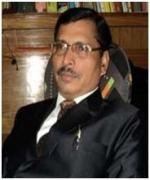Creation and Criticism
ISSN: 2455-9687
(A Quarterly International Peer-reviewed Refereed e-Journal
Devoted to English Language and Literature)
Vol. 02, Issue 04 : Jan 2017

Imagery in Shiv K Kumar’s Where have the Dead Gone? and Jayanta Mahapatra’s Hesitant Light
C L Khatri
Abstract:
The paper is an attempt to anatomize the function and effect of imagery in Shiv K Kumar’s Where Have the Dead Gone? and Jayanta Mahapatra’s Hesitant Light. Poems in these two poetry collections mostly explore the implications of disillusionment, death, violence, loss and ‘degradation of our times’ and they are born of their long and intimate, lived or felt experiences of life. The sources of imagery are largely the same—Nature, mythology, religion, history and the world around. Mahapatra’s poetry has denser texture, more complex poetic design and is more demanding than Shiv K Kumar’s.
Keywords: Imagery, myth, philosophical rumblings, mythopoeic, topography, evocative images
Images drafted into action
are always dodgers,
snarling restively
like circus lions.
When rudely jabbed
showing their dragon teeth,
brandishing their monstrous paws.
But images that come down
epiphanically are
like hail on a
placid summer afternoon. (Shiv K Kumar’s Articulate Silences 30)
Imagery is the ornament, tenor and vehicle of thoughts and poetic sensibility with the ability to lend both clarity and opacity to poetic experiences. For example the effect of epiphanical images can no better be conveyed than with the image of ‘hail’. So with apt use of imagery a poet is able to give his readers tactile, visual, audio, olfactory and even transcendental effect and thereby he effectively transports readers to the realm of his experience. The paper is an attempt to anatomize the function and effect of imagery in the two latest poetry collections of the two living legends of Indian English Poetry—Shiv K Kumar and Jayanta Mahapatra. This comparative study of imagery will give us a peep into their craftsmanship besides bringing out similarities and differences in their handling of images.
Both Shiv K Kumar and Jayanta Mahapatra are well known for their deft use of a wide range of imagery. They by and large continue to write in their own typical manner in which they have been writing—intellectual and urbane poetry in confessional and ironic mode. Poems in these two poetry collections namely Where have the Dead Gone? and Hesitant Light mostly explore the implications of disillusionment, death, violence, loss and ‘degradation of our times’ and they are born of their long and intimate, lived or felt experiences of life. The imagery reinforces the prevailing mood: “A stab wound pierces the fear of the dark again” (Mahapatra: After the Death of a Friend 28) or “Its hard hidden stone / overlooks the growing trade of blood” (Mahapatra: Blue of the Sky 25) or “I hear the dead whispering / like a brood of snakes hissing,..”(Shiv K Kumar: Where have the Dead Gone?13) or “On the earth it’s the same-- / a feud running in the canine family, / over a bone. (Shiv K Kumar: Does it Matter? 38) However, in general the images are bereft of ironic incisiveness but highly evocative with milder tone. Shiv K Kumar has shed much of his mordant irony that one finds in his early works. Quite a good number of poems in ‘Where have the Dead Gone?’ are on death and after death like ‘Death of My Pet Dog’, ‘Death of a Sparrow’, ‘Letter from a Friend (Who Died Five Days Ago)’, ‘The Hospital’, ‘A Funeral Procession’, ‘Ghost’, ‘Haunted House’, ‘Ghost Train’, ‘Death of King Lear’ and a few more. Animal images in some of these poems help him reflect on human predicament about ‘loneliness’ and ‘disinheritance.’ In ‘The Hospital’, Kumar brings out the indifference of the hospital towards patients through the image of “paring their fingernails’’.
Shiv K. Kumar’s imaginative world draws the readers and keeps them hooked with his mimetic content drawn from contemporary pressing issues of the society while we turn to Jayanta Mahapatra for aesthetic value of imagery, its sheer beauty and the challenge it holds for the readers to make guess or wild guess or simply relish the elegance of verbal imagery without bothering for meaning. He takes up an idea or experience and communicates it so thinly at outer level of the images that a reader is left gazing and each one has his own pick and the poet’s take can only be felt or vaguely guessed:
The rain finds its way back
to the door that has been
always left open for it.
And I go on looking for mine,
as I pass by the unchanging garden
that speaks no bound and no farewell,
whose flowers press up a cry in me:
the unheard scream of all dead marionettes,
the roses who have pulled up
their legs fearfully into their bellies. (Mahapatra 19)
The pace with which images come up one after another and are neatly woven into a virtually opaque fabric leaves you spellbound but guessing for what they stand for and their correlation leading to the ultimate communication. The sequence of images drawn from nature –rain—door—for mine (my door)—garden—flowers—dead marionettes—roses—legs into their bellies and two auditory images ‘cry’ and ‘scream’ just allow you to have a feel of loss of some sunny days gone by in poet’s life. One wonders if the poet is crying and screaming because of the loss good old days or simply because of nostalgic feeling or some other weight of the past. However the first stanza vividly echoes a feeling of personal loss at an old age when the poet has ‘no letters to burn’. On the other hand one simple statement speaks loud and clear what images after images in this a thirty five-line poem try to evoke or suggest: “this is a land without light or colour.” (18) If it is judged from the perspective of communication, one will come to endorse the general view of M K Naik’s observation of “either excessively cryptic statement or its opposite verbal redundancy.” But as I said earlier it is an exquisite art work that has its own intrinsic value besides semantic significance. In Mahapatra one has to take the cue from the image itself that is often surrealistic and multiple layers of operation. Also his images present different shades of a thought or the reality he wants to evoke:
Old widowed violins of legends
Fill the air with a mute sleepless wailing
It looks on the trees wearing the blood of men
For clothing instead of leaves
And on the hazy memories that are all
Men can achieve at the end of their lives
It wonders at the earthworms of solitude
Still gnawing the desperate bones of the dead
And follows the terrible look of cities
Which keep a prisoner of the sun (Mahapatra 25)
It is not just the anxiety of old age where one ends up with ‘hazy memories’ but the ‘desperate bones’ suggest desire giving us a feel of Eliot’s “mixing memory and desire” and his “terrible look of cities” takes us to Shiv K Kumar’s idea of present Delhi in ‘Oh Delhi’:
A whore also has some in-built censors,
but you never practiced vasectomy that you
preached to others.
I prophecy that you too will fall
like Nineveh and Babylon
and no new Indraprastha will rise
from your barren ashes. (Kumar 47)
Compared to him, Shiv K Kumar poses a lesser challenge to the reader as the central idea or thought perception is mostly palpable and images whirl round it to reinforce intellectual communication. One can very easily relate the images to his main concern.
I brood over my bruised soul.
I imagine my room filling up with water.
It’s now a lake, and I dive to its bottom
To sit cross-legged like Buddha,
………..
My brain is split into two hemispheres,
Each striking against the other
Like a pair of cymbals.
I am at war with myself. (Kumar: I Am Not at Home 28)
He can be even simpler talking in lighter vein with tongue in cheek as in ‘A Love Poem’:
I have counted all your eyelashes.
It’s the same configuration,
On both sides.” (Kumar 30)
Or just paints a picture for you to watch and leaves you with a passing shot—a thought for the day as in ‘Watching the Clouds’:
What do I see up there
in the skies? Massive bales
of Scottish wool, or a potter’s clay
scattered all over the floor.
The mind can forge them
into any shape—a herd of elephants
or a giant whale
…………………..
A riddle loses its potency
when you pull off its feathers. (Kumar 33)
The evocation of personal and familial memories, philosophical rumblings and predilection for different locales are commonly evident in both these collection albeit with different hues. In Hesitant Light we are taken to Dhauli Hill of Odisha to remind us of the Kaling war and subsequent conversion of Ashoka. “A graveyard without peace is this embroidered / rock with the fading decrees. Unwanted flowers / bloom there in perfect silence, white, alive;” (Mahapatra 55), to the hills and a sickly village of Odisha, “End of the rains in the hills of Odisha. / No wetness drips now from the trees.” (End of the Rains in the Hills of Odissa 56) and to his city in ‘My City: Poem One and My City: Poem Two’ evoking the familial memories of his city and his aching sensibility born out of the present state of affair:
I haven’t not slept all night
Because
The night’s been lying beside me
Stretched out on the mat. ( Mahapatra, 96)
Jayanta Mahapatra is remarkably ingenious in mythopoeic presentation of his region, Odisha—its topography, religious and cultural symbols, its past and present with evocative images. No other poet in India is as known for regional ambience as he is. Kumar is not bound to a place as Mahapatra is. Hence locale centric poems are few and far between. The sources of imagery in both of them are largely the same—Nature, mythology, religion, history and the world around. Mahapatra’s poetry has denser texture, more complex poetic design and is more demanding than Shiv K Kumar’s. Both are master craftsman and write largely for intellectual consumption and are more revered than read today.
Works Cited:
Kumar, Shiv K. Articulate Silences. Calcutta: Writers Workshop, 1970. Print.
---. Where have the Dead Gone? New Delhi: Authorspress, 2014. Print.
Mahapatra, Jayanta. Hesitant Light. New Delhi: Authorspress, 2016. Print.
Naik, M K. Indian English Literature 1980-2000. Delhi: Pencraft International, 2001. Print.
About the Author:
C.L. Khatri, editor of Cyber Literature and of several anthologies of criticism, is an emerging voice in Indian English poetry. He is a bilingual poet writing in English and Hindi. His three poetry collections in English are Kargil (2000), Ripples in the Lake (2006) and Two- Minute Silence (2014). He edited an anthology of poems on world peace Millennium Mood in 2001. He was awarded Michael Madhusudan Acadmay Award for his poetry collection Kargil in 2002. His poems are widely published, anthologized and translated in different languages in India and abroad. Currently he is University Professor, Dept. of English, T.P.S. College, Patna. He resides at “Anandamath”, Harnichak, Anisabad, Patna- 800002, Bihar. India and can be contacted at email drclkhatri@rediffmail.com.


